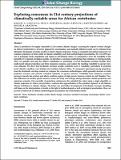Por favor, use este identificador para citar o enlazar a este item:
http://hdl.handle.net/10261/136619COMPARTIR / EXPORTAR:
 SHARE SHARE
 CORE
BASE CORE
BASE
|
|
| Visualizar otros formatos: MARC | Dublin Core | RDF | ORE | MODS | METS | DIDL | DATACITE | |

| Título: | Exploring consensus in 21st century projections of climatically suitable areas for African vertebrates |
Autor: | García, Raquel A.; Burgess, Neil D.; Cabeza, Mar CSIC ORCID; Rahbek, Carsten; Araújo, Miguel B. CSIC ORCID | Palabras clave: | África Bioclimatic envelope model Climate change Consensus Ensemble forecasting Nonanalogue climate Uncertainty Vertebrates |
Fecha de publicación: | abr-2012 | Editor: | Wiley-Blackwell | Citación: | Global Change Biology 18: 1253-1269 (2012) | Resumen: | Africa is predicted to be highly vulnerable to 21st century climatic changes. Assessing the impacts of these changes on Africa's biodiversity is, however, plagued by uncertainties, and markedly different results can be obtained from alternative bioclimatic envelope models or future climate projections. Using an ensemble forecasting framework, we examine projections of future shifts in climatic suitability, and their methodological uncertainties, for over 2500 species of mammals, birds, amphibians and snakes in sub-Saharan Africa. To summarize a priori the variability in the ensemble of 17 general circulation models, we introduce a consensus methodology that combines co-varying models. Thus, we quantify and map the relative contribution to uncertainty of seven bioclimatic envelope models, three multi-model climate projections and three emissions scenarios, and explore the resulting variability in species turnover estimates. We show that bioclimatic envelope models contribute most to variability, particularly in projected novel climatic conditions over Sahelian and southern Saharan Africa. To summarize agreements among projections from the bioclimatic envelope models we compare five consensus methodologies, which generally increase or retain projection accuracy and provide consistent estimates of species turnover. Variability from emissions scenarios increases towards late-century and affects southern regions of high species turnover centred in arid Namibia. Twofold differences in median species turnover across the study area emerge among alternative climate projections and emissions scenarios. Our ensemble of projections underscores the potential bias when using a single algorithm or climate projection for Africa, and provides a cautious first approximation of the potential exposure of sub-Saharan African vertebrates to climatic changes. The future use and further development of bioclimatic envelope modelling will hinge on the interpretation of results in the light of methodological as well as biological uncertainties. Here, we provide a framework to address methodological uncertainties and contextualize results. | Versión del editor: | http://dx.doi.org/ 10.1111/j.1365-2486.2011.02605.x | URI: | http://hdl.handle.net/10261/136619 | DOI: | 10.1111/j.1365-2486.2011.02605.x | ISSN: | 1354-1013 | E-ISSN: | 1365-2486 |
| Aparece en las colecciones: | (MNCN) Artículos |
Ficheros en este ítem:
| Fichero | Descripción | Tamaño | Formato | |
|---|---|---|---|---|
| GlChBiology 18 1253-1269 (2012).pdf | 692,68 kB | Adobe PDF |  Visualizar/Abrir |
CORE Recommender
SCOPUSTM
Citations
131
checked on 02-may-2024
WEB OF SCIENCETM
Citations
129
checked on 27-feb-2024
Page view(s)
223
checked on 12-may-2024
Download(s)
198
checked on 12-may-2024
Google ScholarTM
Check
Altmetric
Altmetric
Este item está licenciado bajo una Licencia Creative Commons

